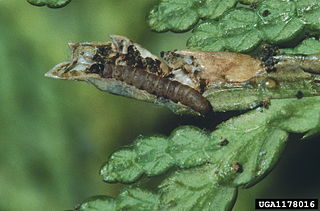Related Research Articles

Curetis bulis, the bright sunbeam, is a species of butterfly belonging to the lycaenid family. It is found in Asia.

Coleotechnites thujaella is a moth of the family Gelechiidae. It is found in the north-eastern parts of the United States, as well as Canada.
Cosmopterix astrapias is a moth of the family Cosmopterigidae. It is known from the United States, Argentina, Costa Rica, Jamaica, Mexico (Tabasco) and Puerto Rico.
Cosmopterix clandestinella is a moth of the family Cosmopterigidae. It is known from the United States.
Cosmopterix etmylaurae is a moth of the family Cosmopterigidae. It is known from Costa Rica.
Cosmopterix gemmiferella is a moth of the family Cosmopterigidae. It is known from the United States and Canada (Ontario).
Cosmopterix lespedezae is a moth of the family Cosmopterigidae. It is known from the United States.
Cosmopterix nishidai is a moth of the family Cosmopterigidae. It is known from Costa Rica.
Cosmopterix pulchrimella, the beautiful cosmopterix moth, is a moth of the family Cosmopterigidae. It is known from the United States and Canada. It is also present in the Palearctic realm, where it is known from the Mediterranean Basin, from Portugal to the western Transcaucasus, north to Switzerland and Hungary. It has also been recorded from the Azores, the Canary Islands and Madeira. It has recently been found in southern England.
Pebobs ipomoeae is a moth of the family Cosmopterigidae. It is known from Florida.
Argyresthia annettella is a moth of the family Yponomeutidae. It is found in North America, including Ohio, Ontario and Quebec.

Holocacista salutans is a moth of the family Heliozelidae. It was described by Edward Meyrick in 1921. It is found in Zimbabwe and the South African provinces of KwaZulu-Natal and Limpopo.

Holocacista capensis is a moth of the family Heliozelidae. It was described by van Nieukerken and Geertsema in 2015. It is found in South Africa.
Chionodes sistrella is a moth in the family Gelechiidae. It is found in North America, where it has been recorded from Alberta, Colorado, Texas, southern Nevada, Arizona, New Mexico, California and Mississippi.
Coleotechnites nigritus is a moth of the family Gelechiidae. It is found in North America, where it has been recorded from Florida, Kentucky and New Hampshire.
Gnorimoschema coquillettella is a moth in the family Gelechiidae. It was described by August Busck in 1902. It is found in North America, where it has been recorded from California and Colorado.
Gnorimoschema ericameriae is a moth in the family Gelechiidae. It was described by Keifer in 1933. It is found in North America, where it has been recorded from California.
Battaristis cyclella is a moth of the family Gelechiidae. It was described by August Busck in 1903. It is found in North America, where it has been recorded from Arizona and Utah.
Aristotelia argentifera is a moth of the family Gelechiidae. It was described by August Busck in 1903. It is found in North America, where it has been recorded from California and western Nevada.
Nealyda kinzelella is a moth of the family Gelechiidae. It was described by August Busck in 1900. It is found in North America, where it has been recorded from Florida.
References
- ↑ "Nealyda Dietz, 1900" at Markku Savela's Lepidoptera and Some Other Life Forms. Retrieved July 7, 2017.
- ↑ Moth Photographers Group at Mississippi State University
- ↑ Proceedings of the United States National Museum 23 (1208): 229
| This article on a moth of the subfamily Anomologinae is a stub. You can help Wikipedia by expanding it. |